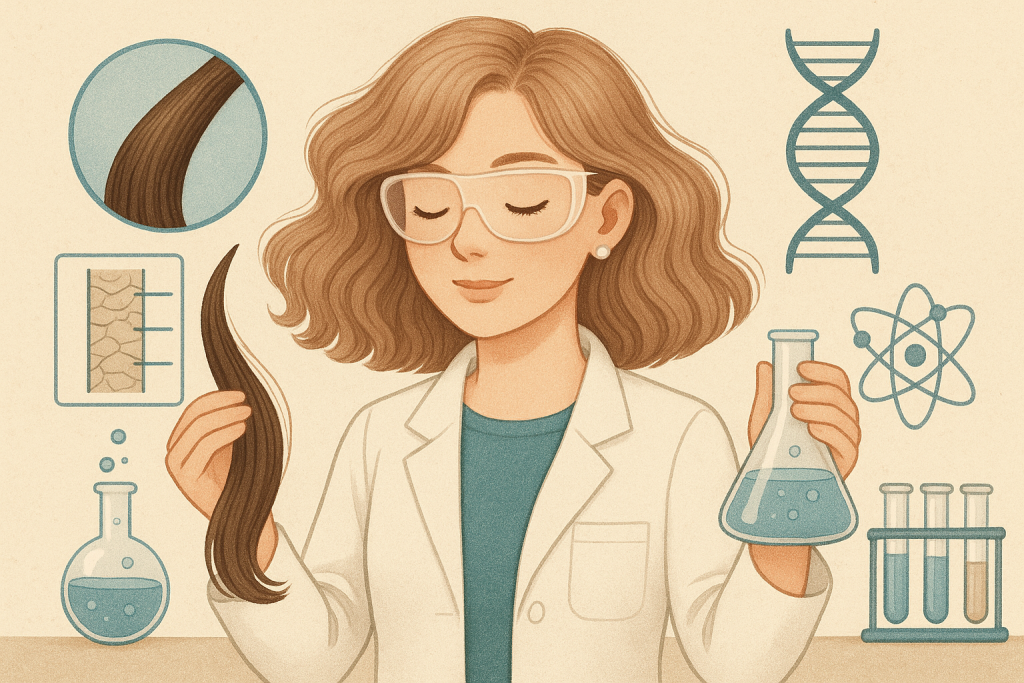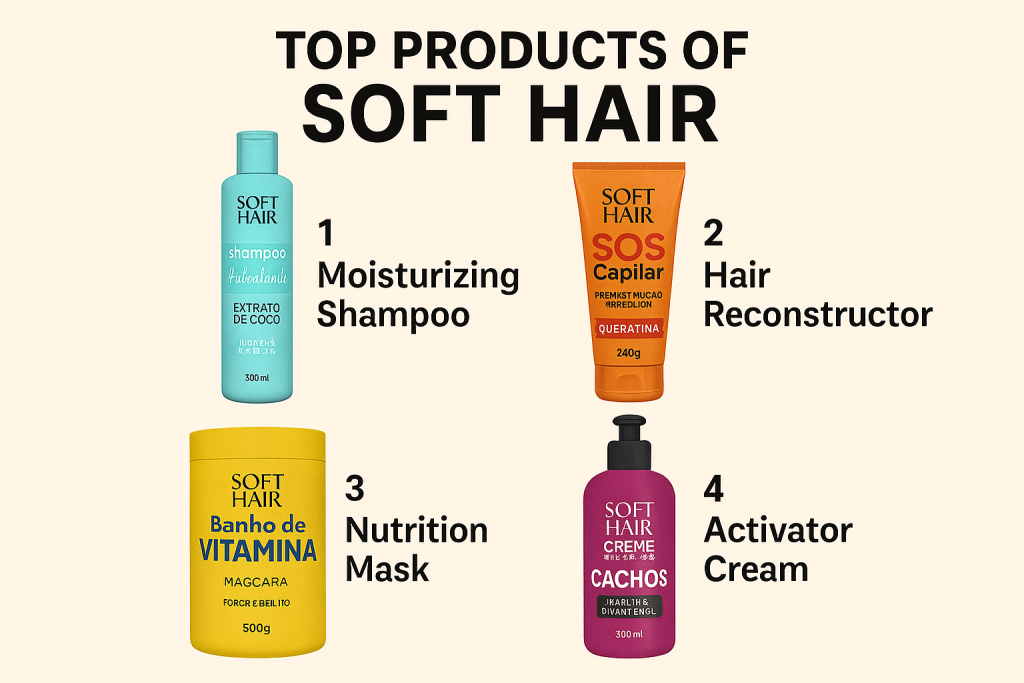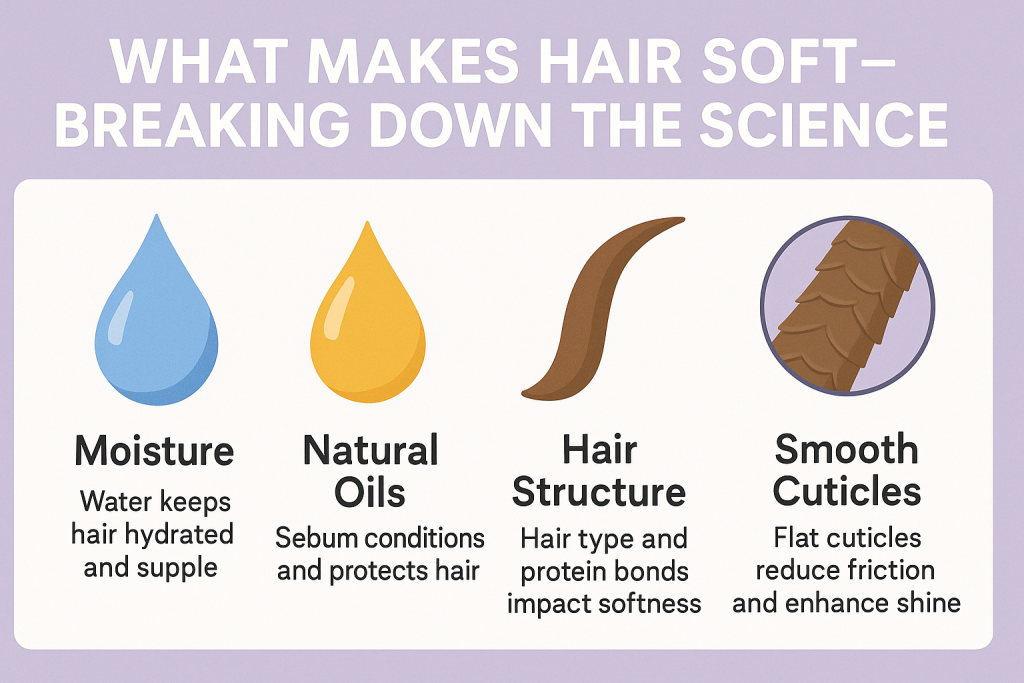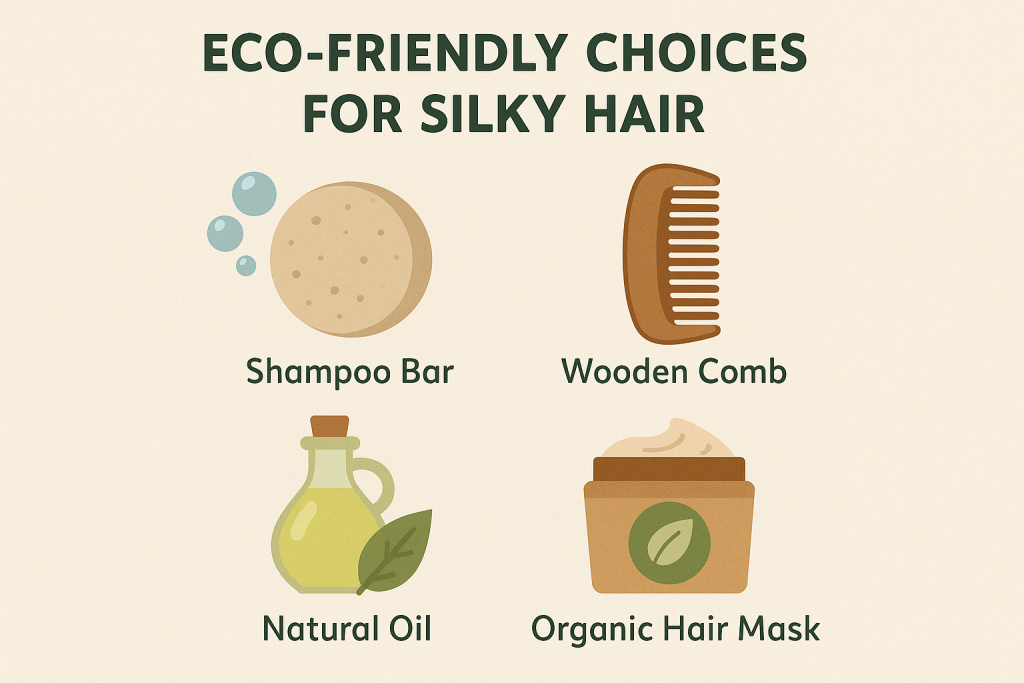Why Soft Hair Matters & The Science Behind Silky Strands

Hey hair lovers! Today, we’re diving into something we all want: that irresistibly soft, run-your-fingers-through-it hair that feels like you’re starring in your own personal shampoo commercial. Finding the right hair products to make hair soft is essential not just for vanity reasons (although we all love that silky feel). It’s about hair health, manageability and giving your strands the TLC they deserve.
Did you know that “soft & smooth” will account for 19% of all hair care conversations in 2024? We’re all thoroughly obsessed with touchable tresses. And it makes perfect sense when you think about it. Healthy hair cuticles lie flat, which makes the hair appear smooth and shiny. I’ve been there, thanks to countless color treatments and heat styling and I can totally relate to the struggle. The right hair treatment can work wonders and help even the most stressed locks look healthy.
What’s stealing your softness? The global market for softening hair masks is valued at approximately $5 billion annually and growing at a 6-8% rate, indicating the vast number of women searching for solutions. But with thousands of products claiming miraculous results, how do you know which ones truly deliver? And that is exactly why I’ve put together this guide. We will look into the science behind soft hair, the best hair care routine for every type of hair and the products that will change your texture. Because everyone deserves to feel the “I can’t stop touching my hair” sensation!
Recommended Hair Products to Make Hair Soft: Top Picks & Real-World Results

These are the proven softeners that my community and I have found to completely transform even the driest, most damaged hair.
Moisture-Rich Shampoos & Conditioners
Moroccanoil Moisture Repair Shampoo & Conditioner ($24-30 each)
Key ingredients: Argan oil, keratin, fatty acids
This set consistently places in the top 10 for softness and scent with 82% consumer agreement. The argan oil-infused formula gently cleanses and deposits moisture.
“After just two washes, my highlighted hair felt like silk again. The scent is heavenly like an expensive perfume and lingers all day.” – Jamie, 34, color-treated hair
Additionally, the product is free of silicones, sulfates and parabens which corresponds to the 35% year-over-year growth in demand for cleaner-formula products. Read about consumer priorities for hair care in this hair care consumer insights report.
OUAI Treatment Mask ($38)
Key ingredients: Shea butter, hydrolyzed keratin, smart keratin
Studies show that smell influences 27% of women’s buying decisions and the subtle rose scent has achieved cult status in the hair care market.
*Before/After: Samantha, 29, curly hair type 3B*
I use it once a week after washing my hair and leave it in for 10 minutes. The difference is incredible—my curls are bouncy, defined and so soft to touch. Worth every penny! —Samantha
Olaplex No. 8 Bond Intense Moisture Mask ($30)
Key ingredients: Bis-aminopropyl diglycol dimaleate (bond-building technology), ceramides
Ideal for damaged or chemically processed hair, this science-backed formula repairs broken bonds and boosts softness.
Leave-In Treatments & Oils
Kenra Platinum Revive Oil ($25)
Key ingredients: Argan oil, vitamin E, silicones
This lightweight oil seals the cuticle for instant softness and shine without greasiness. Kenra is ranked among the top brands for consumer satisfaction, as highlighted in this hair care trends report.
*Before/After on Michael, 42 years old with fine straight hair.*
“As a guy with fine hair, I was concerned oils would make my hair look greasy. This one disappears instantly and leaves my hair touchably soft. My partner can’t stop running their fingers through it!” —Michael
Davines LOVE Smoothing Conditioner ($36)
Key ingredients: Olive extract, minuta olive, panthenol
This leave-in smoothing cream fights frizz and adds supreme softness. Particularly effective for coarse or textured hair.
The best hair care routine uses the right products for women’s specific needs, whether it be repair, moisture, or smoothing.
Ingredient Insights: What Makes Hair Soft—Breaking Down the Science
Let’s get nerdy for a moment and talk about what actually happens when products to make hair soft work their magic. Understanding the science behind these ingredients will help you make better decisions concerning your hair care regime.
Moisture-Boosting Superstars
Argan Oil: This liquid gold doesn’t just coat your hair; it penetrates the hair shaft due to its molecular composition. Rich in vitamin E and fatty acids, it targets the lipid layer of your hair to improve elasticity and boost smoothness.
Best for: Medium to thick hair types.
Coconut Oil: One of the few oils scientifically proven to penetrate the hair shaft, preventing protein loss and reducing water absorption (which causes frizz). It literally fills the gaps in damaged cuticles.
Best for: Medium to thick, porous hair.
Shea Butter: The high vitamin A and E concentration nourishes and softens.
Best for: Coarse, thick, or very dry hair.
Strength & Repair Agents
Keratin: This protein is actually what your hair is made of. When keratin is applied to the hair, it penetrates the cuticle and fills in microscopic gaps in the hair shaft.
Best for: Damaged, processed, or naturally coarse hair.
Panthenol (Pro-Vitamin B5): Panthenol penetrates the cuticle and cortex, binding to the hair structure and holding moisture inside. It promotes volume, softness and elasticity.
Best for: All hair types, especially fine.
Biotin: While biotin works best when ingested, topical application helps strengthen the hair cortex, reducing breakage.
Best for: Weak, brittle hair.
Smoothing & Anti-Frizz Heroes
Silicones (Dimethicone, Cyclomethicone): These create a thin water-resistant coating around the hair shaft, instantly smoothing the cuticle and adding slip. They’re great for instant softness, but product residue may accumulate.
Best for: Frizzy, coarse hair (use sparingly on fine hair).
Aloe Vera: Aloe has a PH similar to that of hair and scalp. Its lightweight moisture effortlessly prevents fine hair from feeling weighed down.
Best for: All hair types, especially sensitive scalps.
| Ingredient | Primary Benefit | Best For Hair Type |
|---|---|---|
| Argan Oil | Softening and Shine | Medium to Thick |
| Coconut Oil | Deep Moisture | Medium to Thick, Porous |
| Shea Butter | Intense Moisture | Coarse, Very Dry |
| Keratin | Strengthening | Damaged, Processed |
| Panthenol | Moisture Retention | All Types |
| Silicones | Instant Smoothing | Frizzy, Coarse |
| Aloe Vera | Gentle Hydration | Fine |
The key to finding your perfect softening formula is understanding which ingredients address your specific hair concerns. If your fine hair gets greasy quickly, stick to lightweight hydrators like aloe and panthenol for softness without heaviness. If your hair is heat damaged, consider pairing it with repair-focused ingredients like keratin and proteins.
Step-by-Step Guide: The Best Hair Care Routine for Softer Hair by Hair Type

What works for my thick waves might weigh down your fine strands or leave your coils still thirsty for moisture. That’s why I’m breaking down the best hair care routine by hair type and how to use hair products that make hair soft for your specific texture.
For Fine/Straight Hair: Lightweight Softness Without Weighing Down
- Use a sulfate-free volumizing shampoo to avoid stripping natural oils. Focus on the scalp, not the hair length.
- Use a lightweight conditioner only on the ends or mid-lengths of your hair. Rinse thoroughly with cool water to help seal the cuticle.
- Heat Protection: If you blow-dry your hair, apply a weightless heat-protectant spray generously and use medium heat.
- Finishing Touch: Apply 2-3 drops of lightweight oil (Kenra Platinum Revive) to the ends of dry hair.
- Once a week, replace your regular conditioner with a light moisture mask.
- Use a clarifying shampoo every 2–3 weeks to remove product buildup, which can make hair feel rough.
Pro Tip: “Fine hair requires a balance of protein and moisture. Too much moisture causes limpness, while too much protein causes stiffness. Alternate the two types of hair treatment for optimal softness and smoothness.” —Hair stylist
Wavy/Curly Hair: Balance Moisture and Definition
- Daily: On non-shampoo days, use a lightweight conditioner to cleanse (true co-washing).
- Hydrating Cleanse: Use a moisturizing, sulfate-free shampoo two to three times a week.
- Moisture-Rich Conditioning: After shampooing, apply a generous amount of curl-enhancing conditioner to your hair. Gently detangle using your fingers or a wide-tooth comb, then rinse out about 80% of the product.
- Leave-in Treatment: When your hair is still soaking wet, apply a curl-specific leave-in conditioner.
- Styling: Use a curl cream or lightweight oil. Air dry or use a diffuser on low heat.
- Deep condition with a protein-moisture balanced mask (15–30 mins).
- Consider an oil pre-shampoo treatment for extra moisture and protection.
Pro Tip: “Curly hair is naturally drier because oils from the scalp can’t travel down the hair shaft as easily. Layer your moisture (instead of relying on just one super rich product).” —Curly specialist
Coily/Thick: Maximum Moisture and Softness
- Minimal Cleansing: Shampoo 1–2 times a week using a moisturizing, sulfate-free formula.
- Deep Conditioning: Apply a generous amount of conditioner, detangle with a wide-tooth comb and leave in for 3–5 minutes before rinsing.
- Leave-In Protection: Apply a generous leave-in conditioner while the hair is dripping wet.
- Seal in Moisture: Layer a curl cream and follow with a natural oil or butter to lock in moisture.
- Protective Styling: Styles like twists or braids help retain moisture and protect the ends.
- Hot oil treatment or intensive moisture mask (heat cap for 30+ minutes).
- Steam treatments for better product penetration.
Pro Tip: “Coily hair types can significantly benefit from the LOC (Liquid, Oil, Cream) or LCO (Liquid, Cream, Oil) method to improve softness levels. Experiment to see which order works best for your specific pattern.” —Texture expert advice
Universal Softness Rules (All Hair Types)
- Sleep on Silk or Satin: Cotton pillowcases absorb moisture from hair and cause friction.
- Regular Trims: Split ends make hair feel rough. Schedule trims every 8–12 weeks.
- Mindful Detangling: Use appropriate tools and detangle gently from ends to roots.
- Lukewarm Water: While hot water helps rinse out product buildup, it can also remove natural oils from the hair.
The perfect hair routine is not about having the most expensive products but rather using the right ones consistently.
Comparisons & Reviews: Which Hair Products Make Hair Softest?
After testing dozens of products and getting feedback from the members of my FB group, I curated a list of the best hair products to make hair soft. This will help you decide which one might suit your needs and budget the best.
| Product | Price | Effectiveness | Key Ingredients | Sustainability | Best For Hair Type | User Rating |
|---|---|---|---|---|---|---|
| Moroccanoil Treatment | $45 | ★★★★★ | Argan oil, silicones | ★★★☆☆ | Medium to thick | 4.8/5 |
| Mask | $39 | ★★★★★ | Rosehip oil, B-vitamins, algae | ★★★★★ | All types | 5/5 |
| Olaplex No. 8 Bond Intense Moisture Mask | $30 | ★★★★★ | Bond-building technology, ceramides | ★★★☆☆ | Damaged, processed | 4/5 |
| The Clean Beauty Champion: Briogeo Don’t Despair, Repair! | $38 | ★★★★★ | Plant oils, protein | ★★★★★ (Eco-Friendly) | All Hair Types | 5/5 |
| The Science-Backed Repair: Olaplex No. 8 | $30 | ★★★★★ | Bond-building technology, ceramides | ★★★☆☆ | Damaged, processed | 5/5 |
| The Budget-Friendly Wonder: The Ordinary Squalane | $8 | ★★★☆☆ | Squalane | ★★★★★ | Fine, frizzy | 4/5 |
- Briogeo Don’t Despair, Repair!
- Pros: No sulfates, silicones, or parabens; deeply nourishing; suitable for all hair types
- Cons: Needs to be left on for 10 minutes; subtle scent (could be a con if you prefer stronger scents)
“As someone with sensitive skin, I appreciate the clean ingredient list. My fine color-treated hair feels stronger and softer but not weighed down. The sustainable packaging is a huge plus!” —Taylor, 29
- Olaplex No. 8
- Pros: Patented bond-building technology, concentrated formula, visible results after one use
- Cons: Higher price per ounce, focused more on repair than immediate softness
“The softness it has restored to my hair is something I thought was lost forever. It feels like my hair is genuinely healthier from the inside out.” —Alex, 26
- The Ordinary Squalane
- Pros: Multi-use (hair, face, body), extremely affordable, no fragrance (good for sensitive individuals)
- Cons: Basic formula without added benefits, may be too simple for severely damaged hair
“I was skeptical about using a face oil on my hair, but this has been a game-changer for my fine, frizzy strands. Just 2-3 drops on my ends keeps them soft and prevents split ends without any greasiness.”
Your best choice depends on what you need or prioritize more for your hair.
Natural Options & Sustainability: Eco-Friendly Choices for Silky Hair

If you’re like me and increasingly conscious about what goes on your body and down the drain, you’ll be happy to know there are eco-friendly hair products to make hair soft to help attain the softness and shine you want. The clean beauty movement is growing by 35% year over year, proving that we don’t have to choose between performance and principles. Read more about this clean beauty trend in this hair care consumer study.
- Davines LOVE Smoothing Conditioner:
Davines is an Italian brand that uses renewable energy sources to manufacture its products. The packaging is biodegradable and food-grade. The LOVE line, which harnesses olive extract from a protected Sicilian farm for exceptional softness and biodiversity support. It is silicone-free, relying on natural emollients to smooth the hair cuticle.
- Innersense Organic Beauty Hydrating Hair Mask:
The company utilizes 100% PCR (post-consumer recycled) packaging and adheres to carbon-neutral shipping methods. The brand’s emphasis on clean formulations, devoid of harmful chemicals, resonates with the current market trend toward transparency and simplicity in product ingredient lists. For more, see this global hair care market report.
- Ethique Wonderbar Solid Conditioner:
Thanks to the cocoa butter, coconut oil and vitamin B5 formulation, it makes hair luxuriously soft and lasts up to five bottles of liquid conditioner. Each bar saves 5 plastic bottles from landfills!
“I was skeptical about switching to a conditioner bar, but my conscience couldn’t handle throwing away another plastic bottle. Not only does it make my curls incredibly soft, but I love knowing that my beauty routine is not hurting the ocean. Plus, it lasts forever!”
Brands are responding with innovative solutions, such as refillable products, plastic-free packaging and more concentrated formulas that require less material.
- Biodegradable or PCR packaging
- Water-free formulations (solid product or concentrate)
- Ethically sourced organic ingredients
- Cruelty-free and vegan product testing
- Supply chain transparency
They feel good (as well as get your skin silky smooth) and align with the things you care about.
FAQs: Your Hair Softening Questions Answered
How long does it take to see results from softening hair products?
Silicone-based serums and oils for immediate softness. Consistent use of high-quality masks and conditioners generally yields results within 2–4 weeks. Premium formulations may work faster due to their concentrated ingredients, but consistency and patience are essential for achieving truly transformative softness.
Can I Use Hair Products to Make Hair Soft on Color-Treated Hair?
Absolutely! In fact, color-treated hair often needs extra-softening mane care. Look for sulfate-free formulas and products rich in natural oils such as argan or coconut. Avoid harsh clarifying shampoos and look for color-safe hair masks with UV protection. The clean beauty trend, which is expanding by 35% year-over-year, focuses on product design without harsh sulfates and silicones.
My Hair Is Fine and Gets Greasy Quickly
Yes, you can still use softening products. Yes! The key is to select lightweight formulations designed specifically for fine hair. Apply softening treatments on the scalp. Look for ingredients like panthenol, squalane, or aloe vera rather than rich butters or thick oils. Use the softening masks no more than once a week and always wash them off carefully.
What’s Better for Softness – Natural Oils or Silicones?
Both have their place! Natural oils (argan, jojoba, coconut) not only nourish the hair but also penetrate deeply into the hair shaft. Silicones smooth the hair and protect it from humidity by forming a coating around the shaft. For the long-term well-being of your hair and sustainable softness, it is best to use both methods: natural oils for treatment and nourishment and silicones occasionally when styling your hair.
How do I maintain soft hair between washes?
- Sleep on a silk or satin pillowcase to reduce friction.
- Use a dry oil spray to refresh the hair midweek (target ends, 2-3 spritzes).
- Protect hair from environmental elements with hats or scarves.
- Use a boar bristle brush to distribute natural oils toward the tips.
- Add a lightweight leave-in conditioner after swimming or heavy sweating.
Can men use the same softening products as women?
Absolutely! Hair structure does not differ by gender, only type and texture do. The growing men’s hair care segment indicates that men are increasingly open to utilizing targeted hair treatment products. The only distinction is the fragrance preference and some men simply prefer neutral scents. The softening ingredients work the same way no matter who uses the product.
Remember, obtaining and maintaining soft hair is a journey, not a destination. It takes time as you allow your locks to grow out the damage, consistent care and the use of appropriate products for your texture. Even the most damaged and coarse hair can be touchably soft again!
References
- Hair Care Consumer Priorities & Insights
- YouGov US – What Shapes Hair Care Consumer Choices?
- Softening Hair Mask Global Market Report
- Global Hair Care Market Analysis
- CEW Hair Care Trends Report
- Statista – US Hair Care Market Overview
- Scented Hair Mist Market Data


Leave a Reply